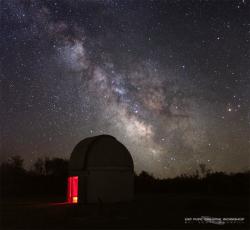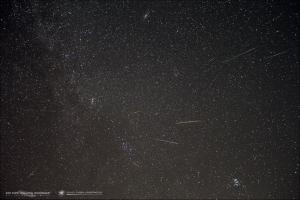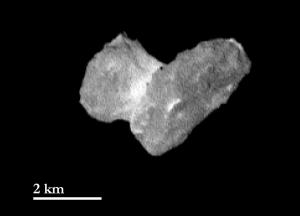
Public Stargazing
- Where:
- Frosty Drew Observatory
- When:
- Friday August 1, 2014 at 7:00 p.m.
- Cost:
- $1 Suggested Donation per Person
Tonight's forecast is looking rather unfavorable for stargazing. With near full cloud cover expected and a chance of showers, we will likely keep the observatory telescopes closed. The 28% waxing crescent Moon sets tonight at 10:37 p.m. and would have left dark skies in its wake. This weekend also brings the annual Seafood Festival to Ninigret Park (home to Frosty Drew). The festival will bring some temporary light pollution to the Charlestown skies, but it will also bring many excellent people to the park. We plan to open the Sky Theatre tonight from 7:00 p.m. - 9:00 p.m. with presentations on celestial objects we would have seen tonight. If skies offer us a chance for a peek, we will open the primary observatory telescope offering views of Saturn. Keep up with us on Twitter (@FrostyDrewOBSY) or Facebook for updates from the observatory on what is happening. If you are checking out the Seafood Festival or just need an astronomy fix, take a chance to stop over at Frosty Drew and learn a bit about what is happening in our cosmic neighborhood.
-------------------------------------------------------------------------
Weekly Happenings
Scott MacNeill
On July 17th, the sublime annual Perseid meteor shower began and will continue until August 24th. The Perseid shower is often referred to as the best meteor shower of the year. Perseid meteors originate from debris left behind by Comet 109P/Swift-Tuttle, which takes 133 years to complete one orbit around the Sun. With warm Summer conditions, meteor rates as high as 100 per hour, and a reputation for producing a high rate of fireball meteors; it is easy to see why the Perseid shower is so revered.
At first glance, this sounds like quite a long meteor shower compared to what we usually hear and read in the media. This is because the majority of media sources will only advertise the peak period of meteor showers, as they should. The peak periods are when a meteor shower really takes off and becomes a spectacle to see. Outside of the peak period, meteors are usually sparse and require long periods of observation to catch only a few passing meteors. This generally applies to all meteor showers. Though my experience with the Perseid shower differ from that rule, making this meteor display stand out among other showers. On average, I have noted equal, if not better, meteor activity outside of the Perseid peak period compared to visible meteor rates during peak period times. The 2014 Perseid peak happens during the early morning hours of August 12th and 13th, which occurs right after the Supermoon on August 10th. The intense brightness of the full Moon is the bane of meteor watching, now add that the full Moon will also be a Supermoon, which is the brightest full Moon of the year, and we have a meteor watching massacre in our midst. Though with the prospect of promising meteor shower activity happening in the weeks surrounding the Perseid peak, we have a redeeming value for this years Moon laden meteor show.
Starting now, set out after moonset (which happens later every night this week), setup a reclining lawn chair or blanket, lay flat on your back with your feet facing the northeast and look at the zenith (straight up). Perseid meteors are generally fast moving meteors that leave bright, colorful trails across the sky. Who knows, you just may catch an excellent show before the Moon crashes the hippest meteor watching party of the year.
With less than a week away from the historic moment when the European Space Agency (ESA) Rosetta mission will arrive at Comet 67P/Churyumov-Gerasimenko, emotions are elevated and all eyes are on Rosetta. The goal of the Rosetta mission will be to acquire orbit around comet 67P, deploy the Philae lander – which will land on the comet's surface, then follow the comet around the Sun and back out to the outer solar system while measuring changes to the comet's nucleus as it makes its solar journey. New photos were released this week of the comet, taken by Rosetta, showing a visible coma (thin atmosphere around the comet) and significantly increased detail in visible features on the comet's surface. If you are not already doing so, get on the ESA Rosetta website and Twitter (@ESA_Rosetta) to connect with the anxiety and suspense of this the historic moment when humans land a spacecraft on a comet.
-Scott


